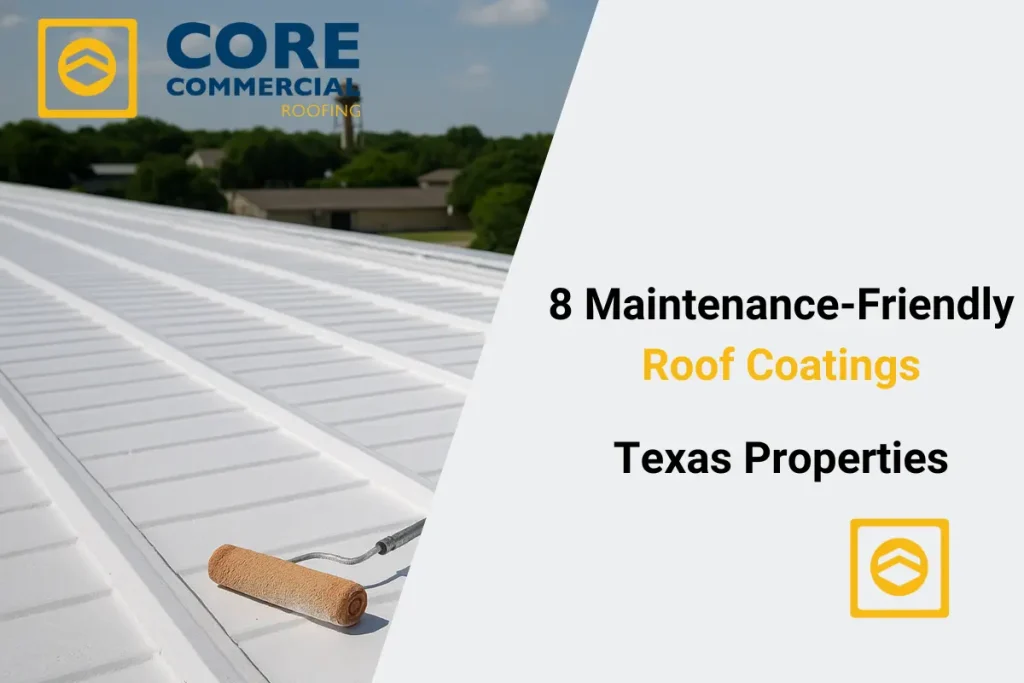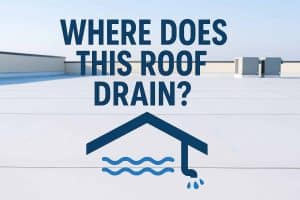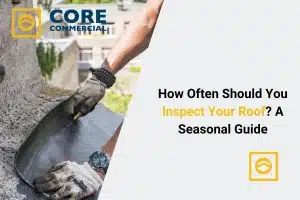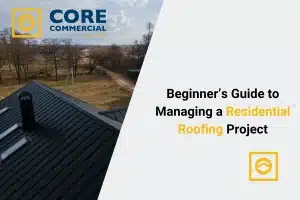Texas roofs endure extreme heat, pounding hail, UV damage, and sudden downpours, all of which speed up leaks, cracks, and expensive repairs. If you’re tired of constant maintenance or worried about early roof failure, a long-lasting roof coating could be your best solution. These coatings don’t just patch problems; they help prevent them.
But be warned: some coatings fail quickly under Texas conditions. The wrong choice can lead to ponding water damage, peeling, or reduced energy efficiency.
In this guide, we’ll break down 8 of the most weather-resistant and low-maintenance roof coatings for Texas homes, metal roofs, and commercial buildings. These options are designed to withstand the state’s brutal climate while lowering energy bills, cutting upkeep, and extending your roof’s life.

In this guide, we’ll walk you through 8 of the most maintenance-friendly roof coatings for Texas homes and buildings. You’ll discover what makes each one special, how they hold up under Texas heat and storms, and how they can save you time, money, and stress down the road. Whether you’re a homeowner, landlord, or commercial property manager, this article will help you make a smart, cost-effective choice that protects your investment for years to come.
Table of Contents
Why Roof Coatings Matter in Texas
Before diving into the top 8 options, let’s take a look at why choosing the right roof coating is so important in Texas.
Extreme Heat & UV Damage
Texas summers are no joke. Roof surfaces in cities like Houston, Dallas, and Austin can reach over 160°F during peak summer months. Prolonged exposure to these extreme temperatures can cause shingles to crack, tar to soften, and roof membranes to break down. A reflective roof coating helps lower surface temperatures, extending the lifespan of your roof and reducing heat transfer into your building.
Storm Resistance
Texas is also home to intense storms, hail, and heavy rain. A quality roof coating forms a seamless barrier that seals out water and resists impact damage, protecting your home from costly leaks and structural issues.
Energy Savings
Cool roof coatings can help reflect sunlight and reduce heat absorption. This results in lower indoor temperatures, particularly in single-story buildings or those with inadequate insulation. In many cases, energy bills drop by 10–30%, especially in the peak summer season.

Lower Maintenance Costs
A good roof coating reduces the need for frequent roof repairs. Instead of patching cracks and chasing leaks, you’ll be able to spend less time on maintenance and more time enjoying peace of mind.
1. Silicone Roof Coating
Best for: Extreme UV protection and water resistance
Silicone coatings are ideal for Texas flat roofs and commercial buildings. They offer superior water resistance and UV reflectivity, making them perfect for the harsh Texas sun.
Benefits:
- Reflects up to 90% of sunlight, reducing cooling costs
- Stands up to ponding water (important for flat roofs)
- Minimal maintenance—no need for frequent recoating
- Flexible enough to expand and contract with heat changes
Why Texas Property Owners Like It:
Silicone is perfect for metal roofs, built-up roofs, or older flat roofs that have pooling water issues. It prevents leaks and keeps buildings cooler with minimal upkeep.
2. Acrylic Roof Coating
Best for: Budget-conscious property owners needing UV protection
Acrylic coatings are water-based and cost-effective, making them a popular choice across Texas for both residential and commercial properties. They’re especially great in drier parts of Texas, where heavy rain isn’t as frequent.
Benefits:
- Highly reflective to reduce indoor heat
- Affordable upfront cost
- Easy to apply and touch up
- Environmentally friendly and low VOC
Why It Works in Texas:
Perfect for areas like El Paso, Lubbock, or San Antonio, where UV protection is critical, and water resistance is a secondary concern. Acrylic coatings help extend roof life without breaking the bank.
3. Polyurethane Roof Coating
Best for: High-traffic roofs and impact resistance
If your roof needs to be walked on—think commercial buildings with HVAC systems—polyurethane is a great choice. It’s tough, durable, and resists Texas hailstorms and foot traffic better than most coatings.
Benefits:
- Superior impact resistance
- Excellent adhesion to most roofing surfaces
- Strong chemical resistance
- Lasts longer under heavy wear and tear
Texas Use Case:
Ideal for schools, hospitals, and industrial buildings across Dallas-Fort Worth or Houston that get both heavy rain and people on the roof.
4. Elastomeric Roof Coating
Best for: Roofs that need flexibility with temperature changes
Texas roofs expand and contract throughout the year. Elastomeric coatings offer great elasticity, which means they move with the roof without cracking or peeling.
Benefits:
- Waterproof and flexible
- Reflects sunlight and insulates
- Seals small cracks and leaks
- Available in a range of formulations for different roof types
Texas Climate Advantage:
This is a versatile, all-climate performer, great for properties in areas like Waco or College Station where temperature swings are common.
5. Bitumen (Asphalt-Based) Roof Coating
Best for: Aging asphalt roofs needing quick restoration
Bitumen coatings are thick, black, and oil-based—great for sealing old asphalt roofs and improving durability. They’re best suited for flat or low-slope roofs.
Benefits:
- Excellent waterproofing
- Extends the life of existing asphalt roofing
- Strong adhesion
- UV resistant with added reflective top layers
Use in Texas:
Useful for older buildings in urban areas like Houston, Austin, and San Antonio, where replacing an aging flat roof might be too costly or disruptive.
6. Reflective Aluminum Roof Coating
Best for: Reflecting heat and adding a metallic finish
Aluminum coatings are made with aluminum flakes suspended in asphalt or resin. They reflect solar rays and give your roof a metallic, shiny finish.
Benefits:
- High reflectivity to cut down heat
- Protects against rust and oxidation
- Affordable option for metal roofs
- Looks sleek and modern
Perfect Fit for Texas:
Popular in West Texas, where heat reflection is essential, and dry air helps maintain the coating’s integrity for years.
7. SEBS (Styrene-Ethylene-Butylene-Styrene) Roof Coating
Best for: Chemical resistance and flexibility
SEBS is a rubber-like thermoplastic coating that offers flexibility, UV resistance, and durability, especially in areas exposed to chemicals or industrial fumes.
Benefits:
- Strong against oil, grease, and harsh chemicals
- Lasts long even with sun and wind exposure
- Great adhesion to many roof types
- Extremely flexible and weather-resistant
Texas Use Case:
Ideal for properties near chemical plants, factories, or warehouses—especially common in the Beaumont–Port Arthur or Houston Ship Channel areas.
8. Cool Roof Coating (Title 24 Compliant Coatings)
Best for: Energy efficiency and lowering utility bills
These coatings are made to meet cool roof standards that reflect sunlight and emit absorbed heat. They’re great for both commercial and residential buildings looking to maximize energy savings.
Benefits:
- Reduces roof temperature by up to 50°F
- Helps lower cooling costs dramatically
- Can qualify for rebates or energy incentives
- Helps extend HVAC lifespan
Texas Benefit:
Extremely helpful in urban heat islands like Houston, Dallas, and Austin, where AC systems work overtime all summer long.
How to Choose the Right Roof Coating for Your Texas Property
Selecting the right roof coating depends on several factors:
- Roof Type: Is your roof flat, low-slope, or steep?
- Local Climate: Do you get more heat, storms, or both?
- Roof Condition: Are you restoring an old roof or protecting a new one?
- Foot Traffic: Will workers or residents walk on the roof?
- Budget: Are you looking for a low-cost solution or a long-term investment?
Take time to inspect your current roof and understand its weaknesses. Then match those needs with the right coating from the list above.
Final Thoughts: Protect Now, Save Later
In a state like Texas, where roofs face year-round punishment from the sun, storms, and heat, investing in a maintenance-friendly roof coating is one of the smartest decisions a property owner can make.
These coatings are not just about making your roof last longer. They’re about:
- Preventing leaks before they start
- Saving money on energy bills
- Cutting down on costly repairs
- Boosting property value and longevity
Whether you own a home in Austin, a warehouse in Houston, or a rental property in Dallas, choosing the right roof coating can protect your investment while giving you peace of mind.
FAQs
What roof coating works best in hot Texas weather?
Silicone and acrylic coatings are top choices for Texas heat. They reflect sunlight, reducing roof temperatures and cooling costs. Silicone is especially durable against UV rays and resists water pooling, making it ideal for flat roofs.
How often should I recoat my Texas roof?
Recoating frequency depends on the coating type and exposure. Typically, roofs need recoating every 10–20 years. Regular inspections can help determine the optimal time for maintenance.
Does roof coating help with Texas energy bills?
Yes, reflective roof coatings can significantly lower energy bills by reducing heat absorption. This leads to less strain on air conditioning systems, especially during hot Texas summers.
Which roof coating is best for flat roofs in Texas?
Silicone coatings are excellent for flat roofs in Texas due to their water resistance and flexibility. They handle ponding water well and provide long-lasting protection against the elements.
Can roof coatings prevent leaks during Texas storms?
Properly applied roof coatings can seal small cracks and seams, offering a waterproof barrier that helps prevent leaks during heavy Texas storms.
Are roof coatings suitable for metal roofs in Texas?
Absolutely. Roof coatings protect metal roofs from rust and corrosion, reflect heat, and extend the roof’s lifespan. They are especially beneficial in Texas’s varied climate.
What is the cost of roof coating in Texas?
Costs vary based on roof size and coating type but generally range from $1.50 to $4.50 per square foot. Investing in quality coating can save money on repairs and energy bills over time.
How do I choose the right roof coating for my Texas home?
Consider factors like roof type, local climate, and specific needs. Consulting with a roofing professional can help determine the best coating option for your property.
Is roof coating a good alternative to roof replacement in Texas?
For many, yes. Roof coatings can extend the life of an existing roof, delay the need for replacement, and provide energy savings, making them a cost-effective solution in Texas.
Do roof coatings qualify for tax deductions in Texas?
In some cases, especially for commercial properties, roof coatings may qualify for tax deductions. It’s advisable to consult with a tax professional to understand eligibility.






